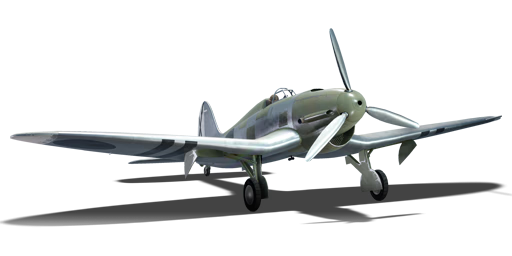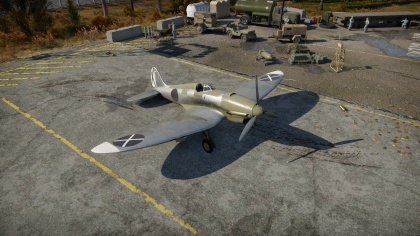He 112 A-0
Contents
| This page is about the aircraft He 112 A-0. For other uses, see He 112 (Disambiguation) |
Description
The He 112 A-0 is a Rank I German fighter with a battle rating of 2.0 (AB), 1.7 (RB), and 2.3 (SB). It was in the game since the start of the Open Beta Test prior to Update 1.29.
The He-112 A-0 is a very solid Rank 1 plane, sitting at 2.0 BR for Arcade and Realistic battles, and at 2.3 BR for Simulator battles. Being fully-metal and equipped with a 20 mm MG C/30L cannon, it is quite a formidable foe in the hands of a decent Rank 1 pilot.
Speed and climb are one of the main factors when using this plane. It is roughly on par with the faster monoplanes at Rank 1, being slightly slower than the F2A and P36G. Climb rate is good when engine upgrades and fuselage upgrades are purchased, at around 16 m/s. While this is much less than some of the top pre-war biplanes, the He-112 is also much faster, better protected, and performs better at altitude.
Play in the vertical when using the He-112. Typical Rank 1 planes consist of biplanes and pre-war monoplanes that are much more manoeuvrable than the He-112. Don't get into a horizontal turn fight with a biplane; energy retention is fairly poor and after a few turns you'll be left a sitting duck for 7.92 and .50 cal MGs to rip you apart. Climb to a favourable height (3-4 km), and then begin boom and zoom attacks, by diving on favourable targets. In realistic battles, do not dive far vertically or perform extreme manoeuvres at high speed; your wings will rip.
One unique aspect of the He-112 A-0 is its excellent cannon, the MG C/30L. Derived from the Flak 38, the MG C/30L possesses very good firepower, and when utilizing HE (high explosive) shells, it is capable of ripping all Rank 1 planes apart with a few short bursts. Be forewarned, however - against bombers, utilize deflection shooting and attack at angles, aiming for the wing. A single 20 mm, regardless of capability, will do you no good if you simply pump shells into a bomber's fuselage.
Overall, remember- the He-112 excels in the vertical and in terms of firepower/durability, being an all-metal monoplane with an excellent cannon.
General info
Flight Performance
| Characteristics | |||||||
|---|---|---|---|---|---|---|---|
| Stock | |||||||
| Max Speed (km/h at 3,200 m) |
Max altitude (meters) |
Turn time (seconds) |
Rate of climb (meters/second) |
Take-off run (meters) | |||
| AB | RB | AB | RB | AB | RB | ||
| 458 | 445 | 7,500 | 17.8 | 18.5 | 9.5 | 9.4 | 350 |
| Upgraded | |||||||
| Max Speed (km/h at 3,200 m) |
Max altitude (meters) | Turn time (seconds) | Rate of climb (meters/second) |
Take-off run (meters) | |||
| AB | RB | AB | RB | AB | RB | ||
| 489 | 473 | 7,500 | 16.3 | 17.0 | 12.8 | 11.1 | 350 |
Details
| Features | ||||
|---|---|---|---|---|
| Combat flap | Take-off flap | Landing flap | Air brakes | Arrestor gear |
| ✓ | ✓ | ✓ | X | X |
| Limits | ||||
|---|---|---|---|---|
| Wing-break speed (km/h) |
Gear limit (km/h) |
Combat flap (km/h) |
Max Static G | |
| + | - | |||
| 650 | 420 | 520 | ~16 | ~16 |
| Optimal velocities | |||
|---|---|---|---|
| Ailerons (km/h) |
Rudder (km/h) |
Elevators (km/h) |
Radiator (km/h) |
| < 280 | < 320 | < 360 | > 250 |
| Compressor (RB/SB) | ||
|---|---|---|
| Setting 1 | ||
| Optimal altitude | 100% Engine power | WEP Engine power |
| 1,900 m | 647 hp | ?,??? hp |
Survivability and armour
- No armour plating
- No armour glazing
- Critical components located at front of aircraft (fuel, pilot, engine, controls)
- More fuel tanks located in wings near fuselage
Armaments
Offensive armament
The He 112 A-0 is armed with:
- 1 x 20 mm MG C/30L cannon, propeller hub mount (100 rpg)
Usage in the battles
The single and unique cannon gives the He 112 an interesting and quite a challenging play style. It has two types of round: APIT and HEIT. APIT is high penetration but causes less internal damage. It is useful against bombers and light ground targets. HEIT is devastating against smaller aircraft. Sometimes just one direct hit will be enough to completely dismantle a target. However, HEIT is unreliable against larger targets, where it often just explodes on the exterior of the target and causes limited damage. Carrying a mixed belt can be a good idea if there are a range of targets available.
The cannon can be very difficult to aim against fast targets, as it has quite a slow rate of fire. Luckily, the plane is maneuverable and turns well, so you can get your cannon on target quite effectively. It is also faster than biplanes and some other monoplanes, meaning that Boom & Zoom tactics work quite well.
Manual Engine Control
| MEC elements | ||||||
|---|---|---|---|---|---|---|
| Mixer | Pitch | Radiator | Supercharger | Turbocharger | ||
| Oil | Water | Type | ||||
| Controllable | Not controllable | Not controllable | Not controllable | Separate | Not ontrollable | Not controllable |
Modules
| Tier | Flight performance | Survivability | Weaponry |
|---|---|---|---|
| I | Fuselage Repair, Radiator | ||
| II | Compressor | Airframe | Offensive 20 mm |
| III | Wing Repair, Engine | ||
| IV | Engine Injection | Cover | New 20 mm Cannons |
Pros and cons
Pros:
- Decent speed.
- Decent rate of climb when fully upgraded.
- Extremely versatile, can do both turn fighting and energy fighting depending on the opposition.
- Excellent cannon ('Air Target' belts have brilliant HEIT rounds).
- APIT rounds have good penetration (over 40 mm), making them good against lightly armoured targets, though it is not recommended to use the cannon in this role.
- Cannon has 100 rounds. The slow rate of fire of the cannon means that you can make these 100 rounds last.
Cons:
- Exposed cockpit.
- No armour to protect the pilot.
- Does not excel at a particular fighting style.
- Sluggish against tougher foes.
- Aiming is difficult, needs a lot of experience.
- Cannon has slow rate of fire.
- No back up machine guns. Once the cannon ammo is gone you will have to wait until reload (AB) or return to the airbase to rearm (RB/SB).
History
Heinkel He 112 V-6 (He 112 A-0) single-engine front-line fighter, issued 1936.
The next prototype of the He 112 V-6 was equipped with an inline 12-cylinder liquid-cooled Junkers Jumo 210C engine with a takeoff power of 680 hp and a three-bladed metal Schwarz variable-pitch propeller.
The greatest difference between this plane and the previous prototype was its armament. In place of two 7.92-mm machine guns, the He 112 V-6 was equipped with a 20-mm Rheinmetall-Borsig MG C/30L cannon with 100 rounds which fired through the hollow propeller shaft.
The He.112V6 fighter underwent its first flight test in July of 1936. Shortly afterwards, the Reich Ministry of Aviation decided to use General Franco’s rebellion in Spain (and the ensuing Civil War) to test new combat aircraft models in real combat and to develop air combat tactics. As a result, in November of 1936 three prototype Bf 109s and one He 112V6 were sent to Spain.
In early December, all four machines arrived at the Spanish port of Cadiz and were taken to Seville’s Tablada airport. The aircraft were placed in the Condor Legion’s 88th Fighter Group, made up of German “volunteers” and armed with German equipment. The Heinkel became the only cannon-carrying fighter, not only in the Legion, but also in the entirety of the rebels’ air force. Therefore, it was decided that the plane would be used as a ground attack aircraft. Together with the Ju 87 A and Hs 123 dive bombers, the Heinkel was used to strike Republican armoured vehicles, field fortifications, and artillery positions. Soon it was nicknamed the “cannon bird” (“kanonenvogel”).
In early 1937, the kanonenvogel took part in the battles over the river Jarama. On March 16, an He.112V6 was flown on its most successful sortie ever by Oberleutnant Wilhelm Balthasar. During an attack on an armoured train, Balthasar managed to hit the ammunition in one of the armoured wagons. The powerful explosion blew the car to pieces and shells detonated all around; as a result, the train was completely destroyed. On the way back, the pilot used his remaining ammunition on a Republican tank and also blew it to pieces.
After this victory, Balthasar was appointed commander of the experimental assault team, which consisted of three two-seater He-45 biplanes and an He-112V6 kanonenvogel. The “cannon bird’s” combat life ended on July 19, 1937. While returning to base, the plane’s motor jammed unexpectedly. During the subsequent emergency landing, the He.112V6’s fuselage snapped in half. The pilot escaped uninjured, but the plane was discarded.
The He.112V6 became the prototype and lead aeroplane of the pre-production He.112 A-0 fighter, of which a total of five were made, two of which were exported to Japan.
Media
An excellent addition to the article will be video guides, as well as screenshots from the game and photos.
Read also
Links to the articles on the War Thunder Wiki that you think will be useful for the reader, for example,
- reference to the series of the aircraft;
- links to approximate analogues of other nations and research trees.
Sources
Paste links to sources and external resources, such as:
- topic on the official game forum;
- page on aircraft encyclopedia;
- other literature.
| Germany fighters | |
|---|---|
| Heinkel | |
| He 51 | He 51 A-1 · He 51 B-1 · He 51 B-2/H · He 51 C-1 · He 51 C-1/L |
| He 100 | He 100 D-1 |
| He 112 | He 112 A-0 · He 112 B-0 · He 112 B-1/U2 · He 112 B-2/U2 · He 112 V-5 |
| Messerschmitt | |
| Bf 109 (Jumo) | Flegel's Bf 109 A · Bf 109 B-1 · Bf 109 C-1 · Bf 109 C-1 |
| Bf 109 (DB-601) | Bf 109 E-1 · Bf 109 E-3 · Bf 109 E-4 · Bf 109 E-7/U2 · Bf 109 F-1 · Bf 109 F-2 · Bf 109 F-4 · Bf 109 F-4/trop |
| Bf 109 (DB-605) | Bf 109 G-2/trop · Bf 109 G-2 · Bf 109 G-6 · Bf 109 G-10 · Bf 109 G-14 · Bf 109 K-4 |
| Focke-Wulf | |
| Fw 190 (early) | Fw 190 A-1 · Fw 190 A-4 · Fw 190 A-5 · Fw 190 A-5 · Fw 190 A-5/U2 · Fw 190 A-5/U14 · Fw 190 A-8 · Fw 190 C |
| Fw 190 (late) | Fw 190 D-9 · Fw 190 D-12 · Fw 190 D-13 |
| Ta 152 | Ta 152 C-3 · Ta 152 H-1 |
| Blohm & Voss | |
| BV 155 | BV 155 B-1 |
| Captured: | |
| USA | ▀P-47D-16-RE · ▀P-47D |
| USSR | ▀La-5FN · ▀Yak-1B |
| Britain | ▀Tempest Mk V |
| Italy | |
| CR.42 | ▀CR.42 · ▀Marcolin's C.R.42 CN |
| G.50 | ▀G.50 serie 2 · ▀G.50 AS serie 7 |
| C.200 | ▀C. 200 serie 3 · ▀C. 200 serie 7 |
| C.202 | ▀C. 202 |
| Finland | ▀Hawk H-75A-2 |






